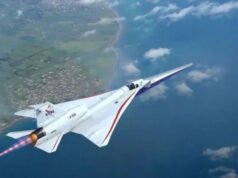Revolutionizing Earth Observation: NASA’s Dynamic Targeting AI and the CogniSAT-6 Breakthrough
Introduction: A New Dawn in Earth Observation
In a transformative leap for space-based intelligence, NASA has successfully tested a revolutionary AI-powered satellite system named Dynamic Targeting, integrated with CogniSAT-6. This cutting-edge system enables satellites to autonomously decide what to observe, when to observe, and how to avoid poor imaging conditions, such as cloudy weather, in real time. With this milestone, NASA sets the stage for a future where satellite autonomy meets machine intelligence, offering more responsive, efficient, and insightful Earth observation.
As climate change, disaster management, agriculture, urban development, and national security increasingly rely on satellite data, Dynamic Targeting promises a significant step forward. Unlike traditional systems that depend on human programming and ground station commands, CogniSAT-6, equipped with on-board AI, acts intelligently and independently—maximizing valuable imaging opportunities and minimizing wasted resources.
1. The Vision Behind Dynamic Targeting
1.1 The Problem with Traditional Earth Observation
Conventional satellite imaging faces several limitations:
- Fixed Schedules: Traditional satellites follow pre-programmed imaging schedules.
- Cloud Obstruction: They often capture cloud-covered or unusable images.
- Delayed Response: Ground-based instructions are often outdated by the time data is processed.
- Limited Efficiency: Vast amounts of satellite data go unused due to poor timing or irrelevant captures.
NASA, in collaboration with industry leaders and academic researchers, set out to solve this issue using artificial intelligence, edge computing, and machine learning algorithms.
1.2 What is Dynamic Targeting?
Dynamic Targeting is a NASA-developed AI system integrated into the satellite’s onboard systems. Its core capabilities include:
- Real-time Decision Making: Determines in real-time whether the current location is optimal for imaging.
- Cloud Avoidance: Detects cloud cover and avoids capturing obstructed views.
- Priority Imaging: Selects targets based on data value, urgency, and mission objectives.
- Edge AI Processing: Analyzes satellite data onboard—before transmission to ground stations.
This AI system represents a paradigm shift from passive observation to active, intelligent imaging.
2. CogniSAT-6: The Testbed for Autonomy in Space
2.1 What is CogniSAT-6?
CogniSAT-6 is a technology demonstration satellite developed by Cognitive Space, in partnership with NASA and other collaborators. It is a 6U CubeSat (small satellite) that served as the first platform to test Dynamic Targeting in real space conditions.
Key Features:
- AI-Enabled Onboard Processor: Supports neural networks and deep learning models.
- Multispectral Imaging Camera: Capable of capturing high-resolution Earth imagery.
- Modular Payload Architecture: Allows rapid AI updates and algorithm testing.
2.2 Mission Successes
In its first operational run, CogniSAT-6:
- Detected cloud presence using real-time image previews.
- Re-routed imaging schedules to clearer areas.
- Captured high-quality, cloud-free data autonomously.
- Reduced bandwidth usage by sending only useful images to Earth.
3. How the AI Works: Inside the Brain of the Satellite
3.1 Onboard Intelligence
The heart of the Dynamic Targeting system lies in AI processors and software agents that perform the following:
- Environmental Analysis: Uses sensors and image previews to assess atmospheric conditions.
- Decision Trees & Neural Networks: Apply logic and pattern recognition to decide next steps.
- Learning Loops: Improve over time by learning which decisions lead to optimal outcomes.
3.2 Data Processing Pipeline
- Capture Preview Image
- Evaluate Weather and Terrain
- Check Against Priority Targets
- Decide to Image or Skip
- Store or Transmit Data
This loop can run multiple times per orbit, allowing the satellite to adapt on the fly.
4. Implications for Earth Observation and Beyond
4.1 Benefits of Dynamic Targeting
✓ Better Data Quality
Only clear, useful images are captured and transmitted.
✓ Faster Response Times
AI decisions occur in seconds, not hours.
✓ Reduced Costs
Less need for human operators and bandwidth.
✓ Scalable Missions
Multiple AI-enabled satellites can work as autonomous constellations.
4.2 Applications in Key Sectors
- Disaster Management: Real-time monitoring of floods, wildfires, and hurricanes.
- Agriculture: Monitoring crop health, irrigation patterns, and pest outbreaks.
- Urban Planning: Updating maps, tracking growth, and observing infrastructure.
- Environmental Monitoring: Assessing deforestation, glacier retreat, ocean pollution.
- Defense & Security: Rapid intelligence without the need for constant uplinks.
5. Future Outlook: Smarter Constellations
NASA’s Dynamic Targeting AI isn’t just a one-off experiment. It lays the groundwork for fully autonomous satellite constellations. These swarms of intelligent satellites will:
- Communicate and coordinate with each other.
- Share tasks across regions and times.
- Predict and adapt to dynamic global events.
- Create a living, learning mesh of orbital intelligence.
6. Collaborations and Global Significance
NASA has been collaborating with several organizations:
- Cognitive Space: AI software integration.
- Maxar Technologies: Imaging hardware support.
- Microsoft Azure Space & Amazon AWS Ground Station: Cloud-based satellite tasking and AI model training.
- NOAA & USGS: Incorporating AI-enhanced data into national geospatial infrastructure.
Globally, agencies like ESA, ISRO, and JAXA are also exploring autonomous satellite systems. NASA’s success with CogniSAT-6 sets a global benchmark.
7. Ethical and Security Considerations
With autonomous systems, new challenges arise:
- Data Bias: AI may prioritize certain geographies or data types.
- Hacking Risks: AI logic may be vulnerable to cyber-attacks.
- Accountability: If the AI fails, who is responsible?
NASA ensures robust testing, audit trails, and layered security for its AI missions.
8. What’s Next? Roadmap Ahead
NASA aims to:
- Scale the technology to larger satellites like Landsat and Sentinel class.
- Enable multi-sensor decision making (thermal, SAR, hyperspectral).
- Launch fleet-wide dynamic scheduling.
- Create AI learning ecosystems across satellite missions.
Planned missions incorporating this tech include:
- Surface Water and Ocean Topography (SWOT)
- Landsat Next
- Earth System Observatory
Conclusion: The Future Has Arrived
NASA’s Dynamic Targeting system on CogniSAT-6 represents a giant leap in autonomous space operations. It demonstrates how artificial intelligence can reshape the very nature of Earth observation—shifting from reactive monitoring to proactive, intelligent surveillance of our planet.
With rapid innovation in edge computing, AI model compression, and real-time analytics, the line between machine perception and human decision-making continues to blur. As this technology evolves, it will empower nations, scientists, disaster responders, and environmentalists with faster, clearer, and smarter data—ultimately helping humanity understand and protect the Earth better than ever before.
🔖 Key Takeaways
- CogniSAT-6 was NASA’s first satellite to test Dynamic Targeting AI.
- The system can autonomously skip cloudy targets and image valuable areas.
- It dramatically improves data relevance, reduces waste, and allows real-time reaction to Earth events.
- It will pave the way for autonomous satellite constellations.
- Ethical safeguards, global collaboration, and future expansion are already underway.
NASA Dynamic Targeting AI system, CogniSAT-6 satellite test mission, AI-based Earth observation satellite, real-time cloud-avoiding satellites, NASA autonomous satellite imaging, small satellite with onboard AI, AI-powered space data collection, space-based Earth monitoring AI















Utterly composed articles, thanks for entropy.